One takeaway from my last post on Portland’s courtyard housing competition was that it makes little sense to squander large chunks of scarce urban land by designing them exclusively for cars. Parking spaces, driveways, and even low-volume residential streets that sit empty most of the day are simply a waste of valuable real estate in growing cities.
So Portland legalized the shared court—a common area in a residential development where cars can drive through (slowly) to park, but that primarily serves as a place for kids to play, neighbors to eat and socialize, or someone to build a sailboat. The landscaping, unconventional paving materials, and narrow or semi-obstructed pathways clearly say to drivers: “This space is going to have people wandering through it, and it’s your responsibility to drive at a safe speed and not mow them down.”

Yet the idea of encouraging toddlers to ride tricycles or nine-year-olds to play kickball in the same spaces with moving cars can seem, well, wrong. After decades of conditioning children to stay out of the street, always look both ways, never assume that cars will stop, any parent has to wonder how safe that can be. But, in a sense, that just illustrates how skewed Americans’ thinking about streets has become.
Even in the US, there are precedents for people and cars amicably sharing space. In grocery store parking lots or campgrounds, drivers expect to encounter meandering pedestrians, wobbly carts, or children on bikes and adjust their speeds accordingly. But when it comes to building city streets, we’ve almost wholly ceded that territory to cars. As the tweet from Strong Towns below illustrates, we’ve created asphalt corridors that allow cars to drive fast, which essentially means they’re unsafe for any other purpose.
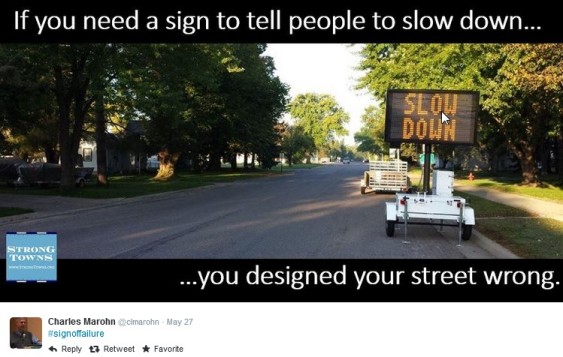
European countries, however, have been designing and retrofitting “shared use” streets that allow residents—and especially children—to reclaim some of that public space that’s historically been ceded to cars. The Dutch woonerf (pronounced vone-erf) and British home zone have been specifically designed so pedestrians, cyclists, and kids at play can safely share the road with slow-moving cars.
In a true woonerf, there’s no curb or separation between the road and sidewalk. Kids are expressly allowed to play in the street, which have relatively low vehicle volumes to begin with. Traffic calming tools—landscaping, ping pong tables in the right of way, narrowing pinch points, textured surfaces, flower planters, meanders, designated entrances and exits—force cars to slow to somewhere between a walking pace and 15 miles per hour. Early studies in the Netherlands found it didn’t really matter what methods were used, as long as they were spaced closely enough that cars couldn’t physically pick up speed.
The evaluations also found that injury accidents in woonerven dropped by 50 percent, according to a case study from the US Federal Highway Administration.
The shared streets below—from residential neighborhoods in Malmo, Sweden and The Methleys Home Zone in Leeds, UK—allow moms to stroll babies and kids to play soccer or ride tricycles in the middle of the road, while cars weave their way around them.
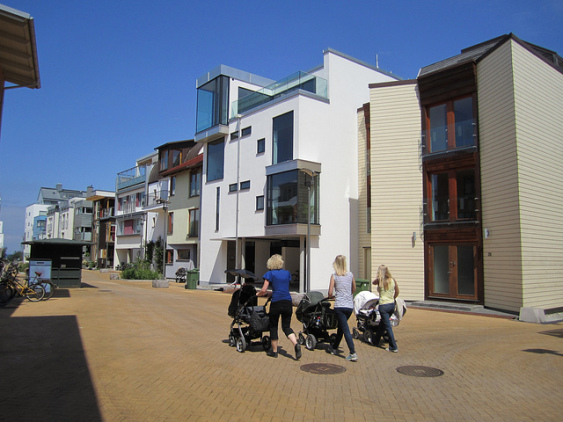

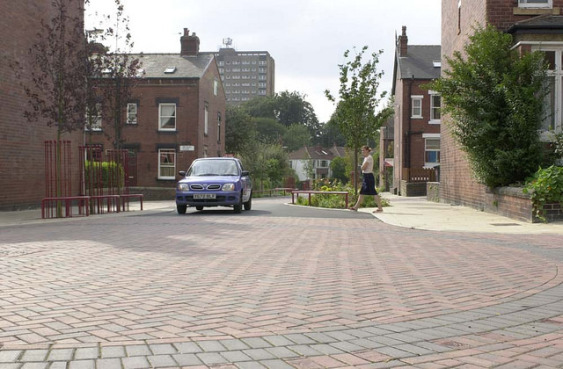
These examples from in Kevalaer, Germany, and Brighton, UK, blur the distinctions between public plaza and roadway in a more commercial area. This type of shared space concept evolved in response to some of the high costs and lessons learned from early experiments with woonerfs. The idea is that by removing traffic signals, signs, and other conventional markings that assign some parts of the road to cars and others to people, the chaos actually forces drivers to slow down and acknowledge their surroundings rather than carelessly bombing through intersections on autopilot.
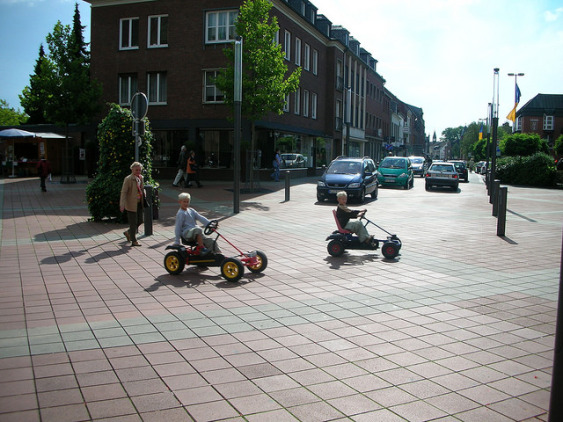

Here in the Northwest, cities have begun experimenting with some elements of shared streets, though few go as far as any commonplace Dutch woonerf. In addition to allowing shared courts in private developments, Portland has rebuilt two blocks of Davis Street through Chinatown as curbless streets that can be closed to vehicles for festivals. South Waterfront eco-district plans call for woonerf-like streets that give priority to pedestrians and cyclists.
Eugene, Oregon, has removed curbs and blurred the distinction between people-and-vehicle-spaces with brick paving and other people-friendly features in some of its downtown blocks.

More recently, the Seattle Parks Department led an effort to transform four blocks of Bell Street through downtown into a linear, woonerf-like park.
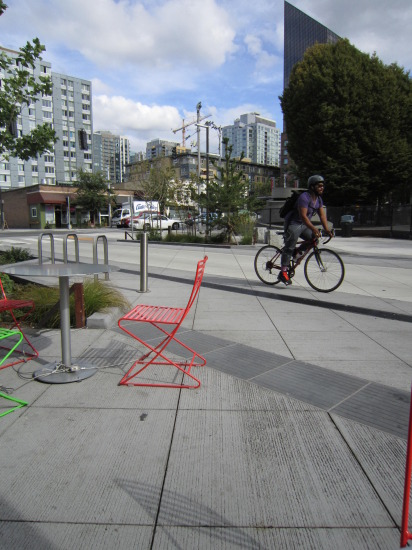
Redevelopment plans for 8th Avenue North through South Lake Union (see below) have envisioned a residential shared-use street that could accommodate children’s play areas, P-patches, outdoor eating nooks, and space for socializing or walking dogs while still allowing traffic to move through. This week, Vulcan announced concrete plans to create a meandering woonerf through that corridor with outdoor “street rooms” that would put people and cyclists on an equal footing with cars.

Obviously, shared use streets only make sense in certain circumstances. And they differ in design and character, depending on whether you’re talking about a low-volume residential street or a busy intersection in the middle of town. But they can be hard for people in North America to wrap their minds around. They go against the deeply ingrained notion that the safest course is separate people from fast-moving cars and then train everyone to follow signs and signals that attempt to keep that peace. They are also commonly opposed by blind, deaf, and people with other disabilities unless their needs are taken into account.
So in my next post, I’ll look at what we can learn from Europe’s experience with shared use streets and detail more places in the Northwest where they may make sense.


Comments are closed.